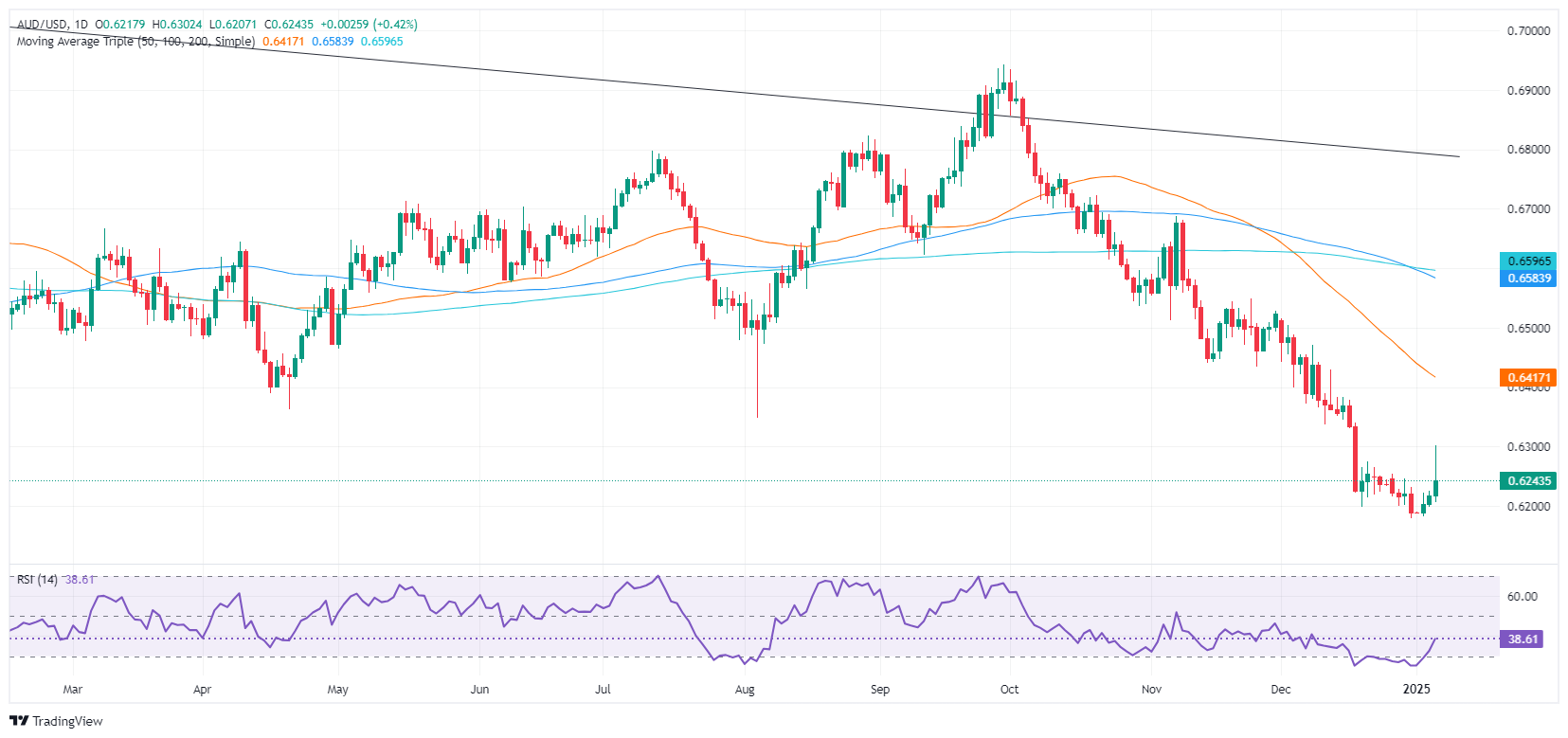- AUD/USD gains after touching a peak of 0.6301 on The Washington Post tariffs article.
- Mixed US economic data shows a dip in Services PMI and a contraction in Factory Orders, fueling market volatility.
- Australian Services PMI indicates economic resilience, boosting optimism as the RBA contemplates future rate cuts.
The Australian Dollar (AUD) has risen from two-year lows and hit the 0.6300 figure yet sits in the mid-range of the 0.62-0.63 area as the Asian Pacific session is about to begin. At the time of writing, the AUD/USD pair trades at 0.6245, gaining over 0.51%.
AUD/USD rises as market sentiment shifts following tariff news
The US Dollar began the week on the defensive following an article in The Washington Post that said that aides of Trump’s team were working on tariffs, not universal but focused on crucial sectors. The market reacted positively, sending the AUD/USD towards 0.6301, while the US Dollar Index (DXY), which measures the buck’s value against six currencies, plunged to a four-day low of 107.75.
However, US President-elect Donald Trump denied the news, underpinning the Greenback, and the AUD/USD retreated.
Data-wise, S&P Global revealed that December business activity in the US deteriorated as the Services PMI dipped from 58.5 to 56.8, exceeding estimates of 56.1. Finally, Factory Orders collapsed from an upwardly revised October of 0.5% and contracted -0.4% MoM in November, exceeding forecasts of -0.3%.
Federal Reserve Governor Lisa Cook crossed the wires and said that the US central bank could adopt a cautious approach with additional interest rate cuts, given a solid economy and stickier inflation than expected.
On Australia’s front, the S&P Global Australia Services PMI rose from 50.4 to 50.8 in December, underscoring the strength of its economy.
Jingyi Pan, Economics Associate Director at S&P Global Market Intelligence, wrote: “The final reading of Australia’s Services PMI offered better news for growth than the flash reading in signaling a stronger services sector expansion at the end of 2024. This was driven by a quicker rise in new business, with external demand notably improving for the first time in four months.”
Ahead of the session, the Australian economy docket will feature monthly inflation data and retail sales figures.
Market players see a 55% chance that the Reserve Bank of Australia (RBA) will cut rates from its 4.35% cash rate to 4.10% in the April 2025 meeting.
In the US, the docket will feature the ISM Services PMI, Initial Jobless Claims and the crucial US Nonfarm Payrolls report this week.
AUD/USD Price Forecast: Technical outlook
The AUD/USD failed to conquer the 0.6300 figure, opening the door for a consolidation around 0.6200 – 0.6250 range. The pair has been carving succesive series of lower highs and lower lows, hinting the downtrend remains intact, with sellers eyeing further downside.
The first support would be 0.6200. The next stop would be the October 13 low of 0.6169 if cleared.
Conversely, if buyers lift the exchange rate above 0.6300, this would exacerbate a rally to 0.6400, ahead of the 50-day Simple Moving Average (SMA) at 0.6424.
Australian Dollar FAQs
One of the most significant factors for the Australian Dollar (AUD) is the level of interest rates set by the Reserve Bank of Australia (RBA). Because Australia is a resource-rich country another key driver is the price of its biggest export, Iron Ore. The health of the Chinese economy, its largest trading partner, is a factor, as well as inflation in Australia, its growth rate and Trade Balance. Market sentiment – whether investors are taking on more risky assets (risk-on) or seeking safe-havens (risk-off) – is also a factor, with risk-on positive for AUD.
The Reserve Bank of Australia (RBA) influences the Australian Dollar (AUD) by setting the level of interest rates that Australian banks can lend to each other. This influences the level of interest rates in the economy as a whole. The main goal of the RBA is to maintain a stable inflation rate of 2-3% by adjusting interest rates up or down. Relatively high interest rates compared to other major central banks support the AUD, and the opposite for relatively low. The RBA can also use quantitative easing and tightening to influence credit conditions, with the former AUD-negative and the latter AUD-positive.
China is Australia’s largest trading partner so the health of the Chinese economy is a major influence on the value of the Australian Dollar (AUD). When the Chinese economy is doing well it purchases more raw materials, goods and services from Australia, lifting demand for the AUD, and pushing up its value. The opposite is the case when the Chinese economy is not growing as fast as expected. Positive or negative surprises in Chinese growth data, therefore, often have a direct impact on the Australian Dollar and its pairs.
Iron Ore is Australia’s largest export, accounting for $118 billion a year according to data from 2021, with China as its primary destination. The price of Iron Ore, therefore, can be a driver of the Australian Dollar. Generally, if the price of Iron Ore rises, AUD also goes up, as aggregate demand for the currency increases. The opposite is the case if the price of Iron Ore falls. Higher Iron Ore prices also tend to result in a greater likelihood of a positive Trade Balance for Australia, which is also positive of the AUD.
The Trade Balance, which is the difference between what a country earns from its exports versus what it pays for its imports, is another factor that can influence the value of the Australian Dollar. If Australia produces highly sought after exports, then its currency will gain in value purely from the surplus demand created from foreign buyers seeking to purchase its exports versus what it spends to purchase imports. Therefore, a positive net Trade Balance strengthens the AUD, with the opposite effect if the Trade Balance is negative.
Information on these pages contains forward-looking statements that involve risks and uncertainties. Markets and instruments profiled on this page are for informational purposes only and should not in any way come across as a recommendation to buy or sell in these assets. You should do your own thorough research before making any investment decisions. FXStreet does not in any way guarantee that this information is free from mistakes, errors, or material misstatements. It also does not guarantee that this information is of a timely nature. Investing in Open Markets involves a great deal of risk, including the loss of all or a portion of your investment, as well as emotional distress. All risks, losses and costs associated with investing, including total loss of principal, are your responsibility. The views and opinions expressed in this article are those of the authors and do not necessarily reflect the official policy or position of FXStreet nor its advertisers. The author will not be held responsible for information that is found at the end of links posted on this page.
If not otherwise explicitly mentioned in the body of the article, at the time of writing, the author has no position in any stock mentioned in this article and no business relationship with any company mentioned. The author has not received compensation for writing this article, other than from FXStreet.
FXStreet and the author do not provide personalized recommendations. The author makes no representations as to the accuracy, completeness, or suitability of this information. FXStreet and the author will not be liable for any errors, omissions or any losses, injuries or damages arising from this information and its display or use. Errors and omissions excepted.
The author and FXStreet are not registered investment advisors and nothing in this article is intended to be investment advice.
Recommended Content
Editors’ Picks

AUD/USD ticks lower toward 0.6200 after Australian Nov inflation data
AUD/USD remains pressured toward 0.6200 following the release of Australian consumer inflation figures, which showed a slowing in the trimmed mean annual CPI , boosting the odds for an April RBA rate cut. Meanwhile, US-China trade war fears and a softer risk tone add to the weight on the pair.

USD/JPY steadies at around 158.00, Fed Minutes awaited
USD/JPY holds steady at atound the 158.00 mark early Wednesday amid uncertainty over further BoJ rate hikes. Further, the Fed's hawkish shift, the recent surge in the US bond yields and a bullish US Dollar support the currency pair, though Trump trade risks cap gains. US ADP data and Fed Minutes eyed.

Gold price consolidates around $2,650 area as traders await FOMC Minutes
Gold price struggles to attract buyers amid the Fed’s hawkish stance and elevated US bond yields. Trade war fears and geopolitical risks lend support to the XAU/USD amid a modest USD downtick. Investors look to the US macro data and FOMC meeting Minutes for some meaningful impetus.

Top 3 Price Prediction Bitcoin, Ethereum, Ripple: Over $560 million in liquidation
Bitcoin hovers around $97,000 on Wednesday after declining more than 5% the previous day. Ethereum and Ripple follow in BTC’s footsteps and decline 8.3% and 6.15% respectively.

Five fundamentals for the week: Nonfarm Payrolls to keep traders on edge in first full week of 2025 Premium
Did the US economy enjoy a strong finish to 2024? That is the question in the first full week of trading in 2025. The all-important NFP stand out, but a look at the Federal Reserve and the Chinese economy is also of interest.

Best Forex Brokers with Low Spreads
VERIFIED Low spreads are crucial for reducing trading costs. Explore top Forex brokers offering competitive spreads and high leverage. Compare options for EUR/USD, GBP/USD, USD/JPY, and Gold.
